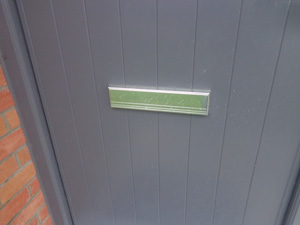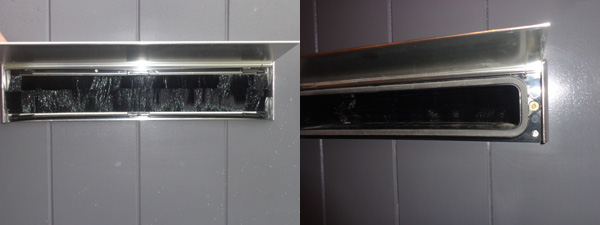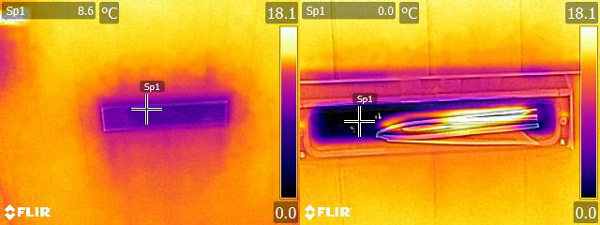
In the quest to find things to explore with my new thermal imaging camera my focus turned to house letter boxes. In PassivHaus circles it’s generally considered a bad idea to put a letter box or a cat flap through a door if you are looking to improve air-tightness and avoid heat losses. Our house does have a letter box so it set me wondering what the impact on the energy efficiency would be.
Now there are letter boxes and letter boxes. Having delivered a few leaflets in my time to houses in the local area, I know that it is very easy to put a paper leaflet through some letter boxes whereas with other types it is practically impossible. Our home has one of the latter.

Our letter box is a 3 part affair. There is a sprung metal plate on the outside. Lift this and you have to get past a bristle brush and then on the inside there is another sprung metal plate with a seal to reduce draughts. Essentially it is designed to stop both letters and cold air from entering the house. Our postman is very diligent but generally we find letters protruding through the letter box rather than on the floor. The result is that the inside flap is raised up for a period of time before we pull the letters inside. So does all this matter?

The simple answer appears to be yes. The thermal images show that with outside temperatures just hovering around freezing then internally the metal of the letter box is around 9°C. When a letter comes through the door and the flap is raised then the temperature is close to zero. So there will be heat loss which will be magnified if letters sit in the door for any length of time.
A couple of small side notes, as I get to know my FLIR C2 camera. I was vaguely aware that infra red emissivity changes with material and that I was photographing a chromed metal flap against a matt painted composite door. Playing with the emissivity settings didn’t really give me a better image so I stuck with the standard camera settings until I know better. I have also discovered that once thermal images are downloaded I can change the temperature range on the desktop software. Useful for comparing different images taken at different times. Normally the camera automatically decides the temperature range used although you can lock it short term.
Air-tightness?
Heat loss was only part of the consideration, what about air-tightness? With the letter box flap closed then there is slight infiltration; hard to be precise without the right test equipment but you could notice it on a cold day. When the letter box flap was pushed open then it was a magnitude worse.
Based on these imprecise observations I would conclude that those who say that a separate letter box is a better idea are probably right. So what are the alternatives? I have seen at least three that are workable; I am sure there are many more:
- Install a wall mounted box outside and seal the letter box in the door. The downside is that you may have to specifically check if the postman has been.
- Add an insulated box inside to catch the letters as they come through the letter box. The box can have a well sealed access door.
- Design an insulated box into the house wall with a well sealed access door internally. See the SuperHomes letterbox website for an example. I would be a bit concerned that I was degrading the wall insulation performance and create other problems but if designed properly it is a good solution.
For cat flaps the challenges are a little greater and I will leave it to others to suggest solutions!
We make a special mail and parcel box that can either be screwed to the wall or approved by building regs to be inserted in the face bricks and half the caivity.
Your pics – particular if you could give me some more info would be helpful to me. Can you phone me to discuss please . 07729169566